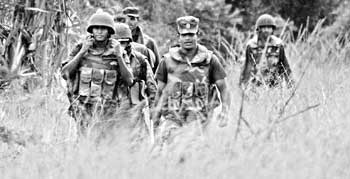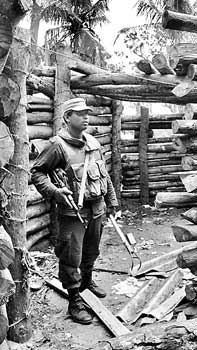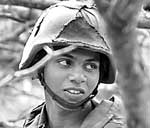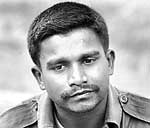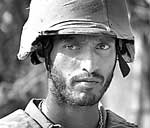
Where men fight and guns boomThough some critics may cast serious doubts about security forces being suddenly able to kill so many LTTE cadres since the current limited offensives began last September along all frontlines, a team from the Sunday Times that visited key frontline positions between Vavuniyaand Mannar on Monday and Tuesday can only refer to the old adage that truth is stranger than fiction. After all these years of fighting in which security forces could have suffered more casualties than the enemy, for the simple reason of sticking to antiquated methods in fighting a fully committed guerrilla force, they have now clearly turned the tables on the Tigers. Earlier the forces had been in the habit of saturating their formations with troops as they advanced only to be decimated by enemy artillery fire and were often interested in holding ground and becoming sitting ducks. But now all that has changed and the Tigers at least for the present have no strategy to counter the small group operations of the army, often behind enemy lines.
The Tigers have received such a battering that none of their big guns like the 122 and 150 milimetre mortars which have been pounding away at military positions till recently have been silent for more than a week in this entire stretch. Either they have been targeted by our own guns as we saw at Periyatampane or they have been taken out by air attacks. Another possibility is that they are low on ammunition with virtually all their transport ships destroyed by the Navy last year. But there is plenty of firing by them using the much smaller 60 milimetre and 80 milimetre mortars. Head of Task Force One, also known as the army’s 58 Division, Brigadier Shavindra Silva does not mince his words when he says they are out to cause maximum attrition on the enemy by drawing him out and taking out as many Tiger combatants as possible. Ably assisted by Lt. Col. Harendra Ranasinghe from the Special Forces, as his staff officer, Brig. Silva maintains meticulous records and for a frontline fighting unit we were surprised that all such records were computerized in their forward headquarters. Making a power point presentation from his base near Mannar Island, he virtually put all critics to shame with some dramatic visuals of their accomplishments in the field. So meticulous are their records that Brig. Silva offers to identify by name 548 enemy combatants killed and 435 wounded since the 58 Division started their advance on September 22 in what is known as the northern rice bowl of Mannar, west of the Giant tank and north of the Main Supply Route leading to Mannar Island This is from confirmations obtained by intercepting Tiger communications after each operation. The kill ratios are clearly reflected in the number of enemy bodies recovered by each side. The army has collected many more bodies of Tigers killed in confrontations though at great risk, than Tigers have been able to collect bodies of soldiers killed. Both sides are in the habit of deploying snipers and other forms of fire to take out those who come to collect bodies. Thirty four bodies had been handed over to the ICRC by both sides so far this month; The Sunday Times learns that virtually all of them had been handed over by the army. Similarly in December, 20 bodies had been handed over and that too mainly by the army. Like the other infantry fighting division 57 operating east of the Giant’s Tank, including in parts of Vavuniya district, 58 division has some of the best fighting officers and men. It comprises four brigades, one of which is made up of commandos. Virtually all men are veterans of many past campaigns and especially of recent ones like the Vakarai and Toppigala operations.
What is the secret of their success in wide open paddy country where the LTTE has attempted to put up stiff resistance and failed, the Task Force One Commander says they cannot operate during the day time as it is open country and they would get decimated if they attempted to advance under light. So it is all night time operations of small units infiltrating behind lines and staking out LTTE positions and then calling in artillery to destroy those positions, followed by break of dawn advances. With there being no civilians remaining in those areas to serve as look outs and with a depleted Tiger cadre strength they appear to be often oblivious to army infiltrators. On Monday night we were the guests of Col. Mervyn Perera, the Deputy Commander of the Mannar area army headquarters in the absence of the base commander Brig. Channa Gunatillake who was on leave. Though we were dead tired having visited the front line positions in highly bumpy Buffel armour plated trucks during the whole day, we found it difficult to sleep due to unfamiliar surroundings and especially with periodic firing from the nearby artillery position. Then at 1:40 a.m. we were witness to a spectacle we would never forget. A salvo of about 20 shells were fired from a multi barrel launcher into enemy territory lighting up the sky with streaks of light for a few seconds as we clearly saw through the lattice work above our door. Though we were a few hundred metres from the firing site, the ground shaking noise was enough to send a chill down our spine. No living creature would want to be at the receiving end of such awesome fire. It immediately gave us a first hand hint as to what the Americans meant when they crowed about giving the Iraqi army “shock and awe” with their fire power as they invaded that country. The following day we queried from Brig. Silva what was the purpose of such a huge barrage, he said it was no haphazard firing and there have been occasions when they have withheld fire altogether despite having solid evidence of movement of top Tiger leaders when there are any fears about the presence of civilians, but in this instance there were no civilians in the area. What was the target? The Brigadier would only say it was a top LTTE commander. From the time we visited the region we learnt that Prabhakaran had dispatched his top commanders like Banu, Sornam, Theepan and Balraj, from other areas in a desperate attempt to halt army gains in the area. One such top man, its head of military intelligence Charles was ambushed and killed recently by an army deep penetration team north of Vidattaltivu in deep Tiger held territory. The Tigers easily being the most ruthless force on earth can’t expect any other treatment in this war, for that is what they have been doing not only to the security forces, but even to innocent civilian victims. Even the once much dreaded IRA was more humane in that often prior to carrying out a terror bomb attack in a civilian area it would issue a warning, even minutes before the explosion so that civilians could get out of harms’ way. Virtually all the brigades of the 58 division are now converging on the outskirts of the town of Adampan, an area where many bitter battles had been fought in the past between the two sides. Though civilians had long left the area, it is a built up area. So it is to be seen what surprises the LTTE can yet spring there. Beyond that to the north is the key Tiger sea landing point at Vidattalativu, where supplies that the LTTE still manages to smuggle in from India are landed. The achievements of the 57 Infantry Fighting Division operating between east of the Giant Tank and parts of Vavuniya are no second to those of the 58 Division. On Monday we began our tour of this division with a send off from its acting commander Brig. Senaka Wickramaratne, who was keen that we see what was being done by the division in the front lines without wasting our time with him in his rear base. At the First Brigade of this division we were greeted to the sight of five bodies of seven LTTE cadres killed the previous evening. They were all in black body bags ready to be transported to Vavuniya for handover to the ICRC for onward transfer to the LTTE. From the opening in one of the bags we were able to see the body of a well built LTTE cadre who had dog tags on his left wrist and around his waist. A battle hardened officer Maj. Nihal Jayasingha explained that the extra dog tags were worn in case one of them gets blown away in a blast. The bodies of two other Tigers killed in the operation were yet lying in the battlefield .as there continued to be firing in the area in the morning. Commander of the 57-1 Brigade Col. G.V. Ravipriya also displayed to us the weaponry recovered from the previous day’s clash, which included 16 new type of deadly grenades manufactured by the LTTE with a green plastic cap instead of a pin, two claymore mines and an assortment of T-56 assault rifles and a specially improvised T-56 assault rifle fitted with a 40 mm grenade launcher. He explained that such weapons are only carried by their military leaders. We also observed groups of soldiers who had just returned from the frontlines with thick beards, resting under trees awaiting transport to go home for a well earned rest. We next witnessed the results of a ten month operation by 57-2 brigade to take the village of Periyatampane, situated about six kilometres from the Puvarasankulam Junction on the Mannar – Vavuniya MSR. Here it is obvious to anyone the LTTE had fought to keep every inch of land and in the process losing as many as 200 cadres and suffering injuries to several hundred more. We were driven to the village by the 57-2 commander Lt. Col. Senarath Bandara, while the area was still being cleared of numerous mines and booby traps. He has a very closely knit team of three other young lieutenant colonels who also accompanied us on this tour, while their men were fighting their way to capture the next LTTE held village within hearing distance at Periyapandirichchan. A well concealed LTTE artillery position, a command centre, and a still intact underground concrete bunker that can hold at least 20 persons during a pounding were some of the impressive defences that the forces had overcome to capture this strategic village. Bishop appeals While virtually the entire civil population has fled Mantai West, Adampan, and Periyatampanai areas where fighting has been raging since September, Mannar Bishop Rayappu Joseph laments that 1200 people still living in Periyamadu and Tachanamadu in close proximity to the Madhu sanctuary are neither receiving any assistance from the NGOs nor are they getting even basic medical attention as the areas have been declared unsafe. The Bishop says those people are surviving solely on whatever assistance extended by his church ICRC’s Head of Sub Delegation in Vavuniya, Clare Meytraud confirmed the situation and said they could not risk their employees there as it was on the edge of the line. Those people could still leave the area as public buses continued to ply in the region. They being farmers were instead continuing to tend their fields. Rt. Rev. Joseph also complains that hundreds of families who were forced to flee villages south of Aravi Aru river (Malwatu Oya in Sinhala), when the army retook Silavatura from the LTTE in early September have still not been allowed to return to their homes that they hastily abandoned at the request of the army. Though the army promised to resettle them soon, so far nothing had been done. Wanni Security Forces Commander Maj. Gen. Jagath Jayasuriya said it was true that they earlier wanted to complete the resettlement by the end of this month, but due to their having to commit troops for unforeseen duties elsewhere like the deployment in the Moneragala district after the Tiger massacre of innocent civilians there, resettlement of displaced civilians had to be put off. The Mannar Bishop also complains of large scale abduction of persons from the Mannar Island and from areas outside it, especially by groups travelling in white vans suspected to be from the intelligence organizations. We were provided with a list of 25 people who had gone missing since December 2006. The list, however gives only two persons who had allegedly been abducted in white vans. He said if the police had placed a guard post at the causeway leading to Mannar Island from the mainland all this could have been prevented. Mannar Assistant Superintendent of Police Laziran Hessian, a veteran STF officer said so far they had not received a single complaint about such abductions. Mannar Citizens Committee’s Project Coordinator J.C.S. Dias contacted in this regard said that once the disappearances are brought to their notice they immediately direct the relatives of such victims to lodge entries with the Mannar police, but if they have not made any such complaints, he would bring it to the notice of the Committee’s Chairman and Secretary for further action. Following a complaint from the Citizens Committee about alleged abductions to Mannar Area Military Commander Brig. Channa Gunatillake about ten days ago, he had arranged a meeting on Friday morning at Thalladi army camp to be attended by the Committee, the police, Navy and himself, but he had put off the meeting at the last minute due to a sudden commitment. Brig. Gunatillake later assured us that he would go into all aspects of these complaints. Army morale on high Unlike in the past when there were heavy engagements resulting in high casualties, Sri Lankan army often saw large numbers deserting its ranks, but now whatever unit we visited we found there was no such exodus, despite there being never ending operations along all the front lines. When we visited the front lines in the Mannar and Vavuniya sectors on Monday and Tuesday, with fire fights taking place only a few hundred metres away we no longer saw any terror stricken soldiers, like animals being taken to slaughter as sometimes we saw in the aftermath of military reversals in the late nineties.
From what we saw it was obvious that they no longer see their plight as hopeless as now possibly for the first time in a longtime they are being properly led and have been well trained to face tasks ahead. We saw young recruits who had been assigned to frontline units after their routine training once again being put through their paces in some camps close to the front. One proof of the worthy officers leading the fighting men, we found on the Uylankulam – Adampan Road on the outskirts of Adampan on Tuesday. This was Lt. Col. Deshapriya Gunawardena commanding the third brigade of the 58 division. When we first visited his command post about one or two kilometres to the rear, he was no where there and his own juniors complained that he had gone to the front to be with his men. When we went in search of him, as his men said, he was very close to the front giving commands with heavy exchanges taking place less than two hundred metres away. And a few hours before we reached the place around noon one of his men had fallen victim to a Tiger sniper in the same area and the victim’s body was taken away only as we reached his base. The position he was operating from was very close to an earlier a Tiger stronghold and had been the scene of heavy exchanges in the morning This gentle giant of a man, easily a six footer, was clearly worshipped by his men for the concern he was showing for their welfare and was risking his life in this manner for his men, while he was due to complete two years in the frontlines in two days to earn a well earned rest in his regimental headquarters Gemunu Watch at Kuruwita and his successor Major Kamal Pinnawala was by his side. In July we saw Lt. Col. Gunawardena in the jungles of Toppigala with his men in similar circumstances just before the liberation of that final sector of the East. What has helped to keep the fighting men in prime mental condition has also been the extra care that the army is taking in attending to their basic requirements unlike in the past when there were major lapses in this area. Lt. Col. Saradha Samarakoon commander of the 10 Gajaba regiment, now part of the 58 – 1 brigade, said they now ensured leave for men every 45 days for bachelors and every 30 days for married men even when units were carrying out operations. Lt. Col. Samarakoon who hosted us to a sumptuous lunch on Tuesday at his forward headquarters said it would go a long way to further boost the morale of their fighting men if some of the celebrities in the country, whom these men normally worship, would come and see them. “They do not need to bring anything even as so much as a toffee. They only need to come and speak to the men to show their appreciation and a pat on the back will be more than enough”, he said. The 10th Gajaba regiment commander also noted that soldiers would be more appreciative if the sacrifice they are making on behalf of the country got more coverage in the media. He too is a readily accessible officer, who has told about fifty Tamil families living in close vicinity of his headquarters that if they encounter any problem to report to him at once for redress. While the Lt. Col. was accompanying us to one of the small tanks adjoining the Giant tank, a greater part of its bund was now under the control of his men and there was firing not far from us; we spoke with lance corporal Upali Samararatne from Bandarawela providing us security. He said he had joined the army at age 18 and had been with the unit for ten years and he hoped to complete his entire quota of 22 years with the regiment even though he was married and has a two year old daughter. Cpl. Samararatne said because of the improved facilities provided by the army ten more youngsters from his village had joined the forces in recent months in addition to 20 others already serving in the army. At the eighth Sinha regiment, which is part of the 58 Divisions Second brigade, involved in clearing areas of Adampan West, we were accompanied to the front bunker line, which is obviously the northern most thrust of the division, by Maj. Rohan Ponnamperuma. Here too soldiers who we spoke with were quite adamant in completing their task. Cpl. Indika Mahanaga (34) of Hanguranketha said he had already served 15 years with his unit. A father of a nine year old daughter and a five year old son, Indika said he had no intention of leaving the army. Here we also ran into an army deserter who had returned to his unit after about one year. Rifleman Wimalasiri Banda from Randenigala said they now felt they were finally achieving something. He has already lost an elder brother serving in the army to a mine explosion. He is the father of two sons aged seven and one. According to him he deserted the army to attend to some personal problems and once he overcame them he returned. Soldier DB. Piyaratne (22) from a family of seven brothers and one sister said on leaving school he had worked as a gem miner like most of his brothers, but later he joined the army as it provided a better pay. Asked whether they were satisfied with the food they were getting at the front, he said when they were on operations they had to survive on field rations, but once they got to man the bunkers they were being provided cooked meals always containing meat, eggs or fish. All soldiers we spoke with said they were now provided better transport facilities to and from the front. Up to Vavuniya town they are provided transport by armour plated Buffel trucks and from there they are provided with the army’s Liberty Bus service to proceed to Anuradhapura. They are also provided places to wash and change in these towns before they depart for home destinations. |
|
||||||
|| Front
Page | News | Editorial | Columns | Sports | Plus | Financial
Times | International | Mirror | TV
Times | Funday
Times ||
|
| |
Reproduction of articles permitted when used without any alterations to contents and the source. |
© Copyright
2008 | Wijeya
Newspapers Ltd.Colombo. Sri Lanka. All Rights Reserved. |
